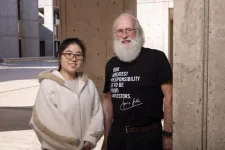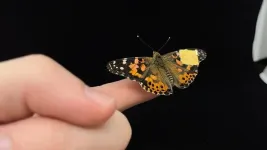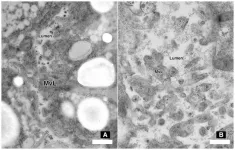(Press-News.org) Researchers at the Broad Institute of MIT and Harvard have developed a gene-editing treatment for prion disease that extends lifespan by about 50 percent in a mouse model of the fatal neurodegenerative condition. The treatment, which uses base editing to make a single-letter change in DNA, reduced levels of the disease-causing prion protein in the brain by as much as 60 percent.
There is currently no cure for prion disease, and the new approach could be an important step towards treatments that prevent the disease or slow its progression in patients who have already developed symptoms. A base-editing approach could also likely be a one-time treatment for all prion disease patients regardless of the genetic mutation causing their disease.
The work, led by Broad senior group leaders Sonia Vallabh and Eric Minikel, as well as Broad core institute member David Liu, is the first demonstration that lowering levels of the prion protein improves lifespan in animals that have been infected with a human version of the protein. The findings appear in Nature Medicine.
“As a patient scientist, I think often about how lucky we are to be coming at this problem now,” said Vallabh. “When I received my genetic test report in 2011, the world had never heard of base editing. It’s a huge privilege to have the opportunity to point these powerful new tools at our disease.”
“It’s been incredible to merge our disease models with this gene-editing technology,” Minikel said.
“Our lab is very fortunate to have the opportunity to work with Eric and Sonia, who have brought tremendous expertise, scientific rigor, and total dedication to this collaboration,” said Liu, the Richard Merkin Professor and director of the Merkin Institute of Transformative Technologies in Healthcare at the Broad. “We are hopeful the results might inform the future development of a one-time treatment for this important class of diseases.”
Meirui An and Jessie Davis, both graduate students in Liu’s lab at the time of the project, are co-first authors on the study.
“Prion disease has a lot of different origins — some are genetic, some occur spontaneously, and others stem from infections — but we believe this base editing strategy can be applied to all of these forms of prion disease,” An said. “This has the potential to be a really promising strategy.”
A long-awaited strategy
Vallabh and Minikel have been studying prion disease since 2012, after Vallabh’s mother passed away from a form of the disease called fatal familial insomnia and Vallabh found out that she had inherited the disease-causing mutation. The wife-and-husband team started a lab at the Broad with a singular focus: preventing and treating prion disease within their lifetime.
Not long after the development of CRISPR-Cas9 gene editing in 2013, Vallabh and Minikel began thinking about whether CRISPR could be used to disrupt the gene encoding the prion protein. Minikel remembers thinking, “There’s something really promising there. We should be able to do something with this.”
In 2018, Liu, who works on the same floor as Minikel and Vallabh at Broad, approached them and proposed a collaboration. His lab had just developed base editing, a gene-editing approach that makes single-letter changes in DNA and can shut down protein production using strategies including installing a “stop” signal in the genetic code.
Vallabh and Minikel knew from studying population databases such as the Genome Aggregation Database (gnomAD) that R37X, a naturally occurring mutation in the prion gene, reduced protein levels without harmful side effects in people. That gave them hope that installing the same mutation using base editing might be protective against the disease.
“We realized it was this golden opportunity to use human genetics to inform base editing,” Minikel said.
Brain delivery
In the new study, the team showed that a base editor installed the R37X edit in human cells efficiently and with few unwanted byproducts. But the researchers needed to deliver the base editors to the brain.
Building on previous work by the vector-engineering lab of Ben Deverman at the Broad, the team developed a pair of adeno-associated viruses (AAVs) to package and deliver the base-editing machinery to brain cells. They then administered the AAVs to mice infected with the human prion protein.
On average, the system installed the R37X edit in 37 percent of copies of the gene, reducing levels of the prion protein by 50 percent compared to mice without the treatment. The mice also lived about 50 percent longer.
The scientists made a swath of improvements to their system to boost editing efficiency and limit delivery to other tissues. With their improved system, they observed 63 percent lower prion protein levels at a six-fold lower dose of AAVs.
In the future, the team hopes to make the base-editing cargo smaller, because dual AAVs can be costly to produce. They also plan to develop a strategy that uses prime editing — which can install more complicated DNA edits than single-base changes — to install a protective mutation that does not shut down protein production but rather ensures that the prion protein itself is benign.
“There’s still a long way to go to make this a therapy,” Minikel said. “But it’s really exciting to see how much is possible.”
***
This work was supported in part by the National Institutes of Health, Prion Alliance, and the Howard Hughes Medical Institute.
Paper cited
An M, Davis JR, et al. In vivo base editing extends lifespan of a humanized mouse model of prion disease. Nature Medicine. Online January 14, 2025. DOI: 10.1038/s41591-024-03466-w.
END
Gene editing extends lifespan in mouse model of prion disease
A single-letter edit in DNA reduces levels of the disease-causing prion protein in the brain and could lead to a preventative, one-time treatment for the deadly neurodegenerative disorder.
2025-01-14
ELSE PRESS RELEASES FROM THIS DATE:
Putting a lid on excess cholesterol to halt bladder cancer cell growth
2025-01-14
LA JOLLA (January 14, 2025)—Like all cancers, bladder cancer develops when abnormal cells start to multiply out of control. But what if we could put a lid on their growth?
Previous studies showed that a protein called PIN1 helps cancers initiate and progress, but its exact role in tumor development has remained unclear. Now, cancer biologists at the Salk Institute have discovered that PIN1 is a significant driver of bladder cancer and revealed that it works by triggering the synthesis of cholesterol—a membrane lipid essential for cancer cells to grow.
After mapping out the molecular pathway between PIN1 and ...
Genetic mutation linked to higher SARS-CoV-2 risk
2025-01-14
RIVERSIDE, Calif. -- Researchers have identified a novel genetic risk factor for SARS-CoV-2 infection, providing new insights into the virus’ ability to invade human cells. SARS-CoV-2 is the virus that spreads COVID-19.
The study, led by immunologist Declan McCole at the University of California, Riverside, shows that a loss-of-function variant in the phosphatase gene PTPN2, commonly associated with autoimmune diseases, can increase expression of the SARS-CoV-2 receptor ACE2, making cells more susceptible to viral invasion.
A loss-of-function ...
UC Irvine, Columbia University researchers invent soft, bioelectronic sensor implant
2025-01-14
Irvine, Calif., Jan. 14, 2025 — Researchers at the University of California, Irvine and New York’s Columbia University have embedded transistors in a soft, conformable material to create a biocompatible sensor implant that monitors neurological functions through successive phases of a patient’s development.
In a paper published recently in Nature Communications, the UC Irvine scientists describe their construction of complementary, internal, ion-gated, organic electrochemical transistors that are more amenable ...
Harnessing nature to defend soybean roots
2025-01-14
The microscopic soybean cyst nematode (SCN) may be small, but it has a massive impact. This pest latches onto soybean roots, feeding on their nutrients and leaving a trail of destruction that costs farmers billions in yield losses each year. Unfortunately, current methods to combat SCN are faltering as the pest grows resistant to traditional controls. But new research is now offering a glimmer of hope.
A collaborative team of scientists from BASF Agricultural Solutions and the Advanced Bioimaging Laboratory at the Donald Danforth Plant Science Center are working on a potential solution: ...
Yes, college students gain holiday weight too—but in the form of muscle not fat
2025-01-14
With the holidays behind us, many Americans are seeing the numbers on the scale go up a pound or two. In fact, data shows that many American midlife and older adults gain 1 to 1.5 pounds over the November through January holiday period. Though not harmful on its own, even a small amount of holiday weight gain in the form of fat can negatively affect health. People often fail to lose the extra weight, which leads to significant cumulative weight gain over the years and contributes to health concerns.
Based on new research, we now know that college students gain the same amount of weight as older ...
Beach guardians: How hidden microbes protect coastal waters in a changing climate
2025-01-14
A hidden world teeming with life lies below beach sands. New Stanford-led research sheds light on how microbial communities in coastal groundwater respond to infiltrating seawater. The study, published Dec. 22 in Environmental Microbiology, reveals the diversity of microbial life inhabiting these critical ecosystems and what might happen if they are inundated by rising seas.
“Beaches can act as a filter between land and sea, processing groundwater and associated chemicals before they reach the ocean,” said study co-first author Jessica Bullington, a Ph.D. student in Earth system science in the Stanford Doerr School of Sustainability. “Understanding ...
Rice researchers unlock new insights into tellurene, paving the way for next-gen electronics
2025-01-14
HOUSTON – (Jan. 14, 2025) – To describe how matter works at infinitesimal scales, researchers designate collective behaviors with single concepts ⎯ like calling a group of birds flying in sync a “flock” or “murmuration.” Known as quasiparticles, the phenomena these concepts refer to could be the key to next-generation technologies.
In a recent study published in Science Advances, a team of researchers led by Shengxi Huang, associate professor of electrical and computer engineering and materials science and nanoengineering at Rice, describe how one such type of quasiparticle ⎯ polarons ⎯ behaves in tellurene, a nanomaterial first synthesized ...
New potential treatment for inherited blinding disease retinitis pigmentosa
2025-01-14
Two new compounds may be able to treat retinitis pigmentosa, a group of inherited eye diseases that cause blindness. The compounds, described in a study published January 14th in the open-access journal PLOS Biology by Beata Jastrzebska from Case Western Reserve University, US, and colleagues, were identified using a virtual screening approach.
In retinitis pigmentosa, the retina protein rhodopsin is often misfolded due to genetic mutations, causing retinal cells to die off and leading to progressive blindness. Small molecules to correct rhodopsin folding are urgently needed to treat the estimated 100,000 ...
Following a 2005 policy, episiotomy rates have reduced in France without an overall increase in anal sphincter injuries during labor, with more research needed to confirm the safest rate of episiotomi
2025-01-14
Following a 2005 policy, episiotomy rates have reduced in France without an overall increase in anal sphincter injuries during labor, with more research needed to confirm the safest rate of episiotomies and the risks to specific subgroups
In your coverage, please use this URL to provide access to the freely available paper in PLOS Medicine: http://journals.plos.org/plosmedicine/article?id=10.1371/journal.pmed.1004501
Article title: Episiotomies and obstetric anal sphincter injuries following a restrictive episiotomy policy in France: An analysis of the 2010, 2016, and 2021 National Perinatal Surveys
Author countries: France, Switzerland
Funding: ...
Rats anticipate location of food-guarding robots when foraging
2025-01-14
Researchers find that rats create neurological maps of places to avoid after experiencing a threat and think about these locations when exhibiting worry-related behaviors. These findings—which A. David Redish of the University of Minnesota, US, and colleagues presented in the open-access journal PLOS Biology on January 14th—may provide insight into the neuroscience of common psychological conditions like anxiety.
There are many theories as to why people experience anxiety. One is that anxiety is associated with a psychological phenomenon called “approach-avoidance conflict,” where ...
LAST 30 PRESS RELEASES:
What determines the fate of a T cell?
Candida auris: genetic process revealed which could be treatment target for deadly fungal disease
Groundbreaking discovery turns household plastic recycling into anti-cancer medication
Blocking a key inflammatory pathway improves liver structure and vascular function in cirrhosis, study finds
Continuous spread: Raccoon roundworm detected in nine European countries
HKUST Engineering researchers developed a novel photodetector to enhance the performance of on-chip light monitoring
Strategic river sensors could have forewarned of Texas Camp flood disaster
Drone sampling of whale breath reveals first evidence of potentially deadly virus in Arctic
Roman soldiers defending Hadrian’s Wall infected by parasites, study finds
Pinochet’s prisoners were tormented with music but still found solace in it, a new book reveals
Fertility remains high in rural Tanzania despite access to family planning
AI-assisted device can improve autism care access
Kinetic careers
Uncovering how parasitic plants avoid attacking themselves to improve crop resistance
Nanoparticle vaccine strategy could protect against Ebola and other deadly filoviruses
Study finds brain care score can predict risk of stroke across racial groups
Key lung immune cells can intensify allergic reactions
Do hormones explain why women experience more gut pain?
New materials conduct ions in solids as easily as in liquids
Breakthrough of the Year: Renewable energy begins to eclipse fossil fuel-based sources
LLM use is reshaping scientific enterprise by increasing output, reducing quality and more
Introducing LightGen, a chip for ultra-fast, ultra-efficient generative AI
Astronomers see fireworks from violent collisions around nearby star
ACC/AHA issue new guideline on managing congenital heart disease in adults
Cosmic crash caught on camera
Is talented youth nurtured the wrong way? New study shows: top performers develop differently than assumed
Ants: An untapped resource in the development of antibiotics?
Archaeologists use AI to create prehistoric video game
Mitochondria migrate toward the cell membrane in response to high glucose levels
Tiny viral switch offers hope against drug-resistant bacteria
[Press-News.org] Gene editing extends lifespan in mouse model of prion diseaseA single-letter edit in DNA reduces levels of the disease-causing prion protein in the brain and could lead to a preventative, one-time treatment for the deadly neurodegenerative disorder.






